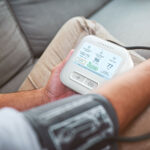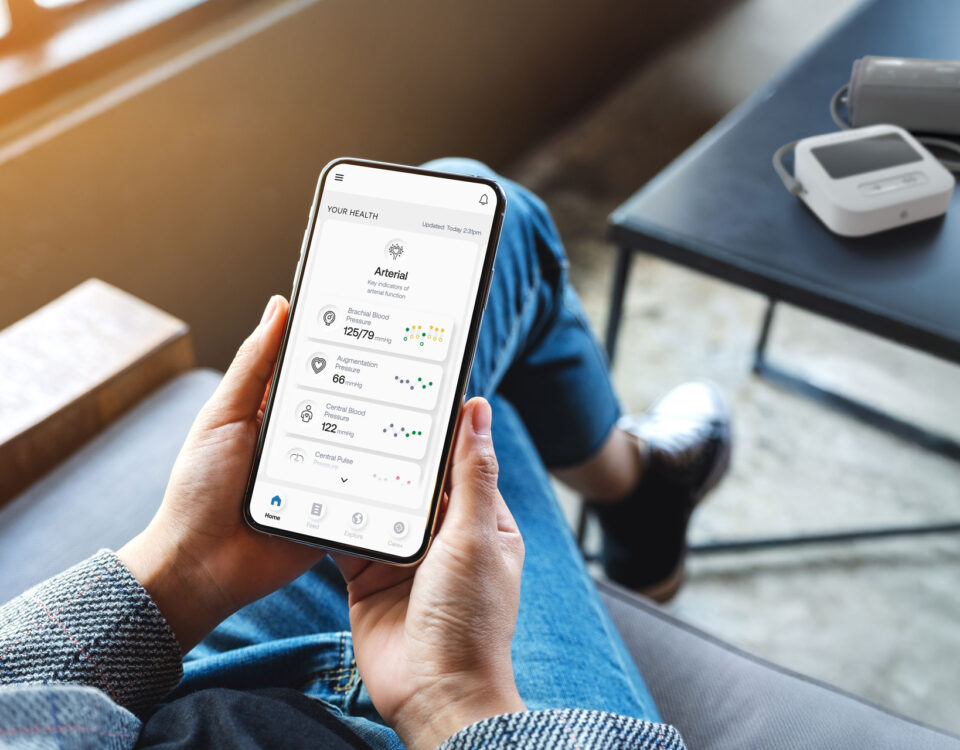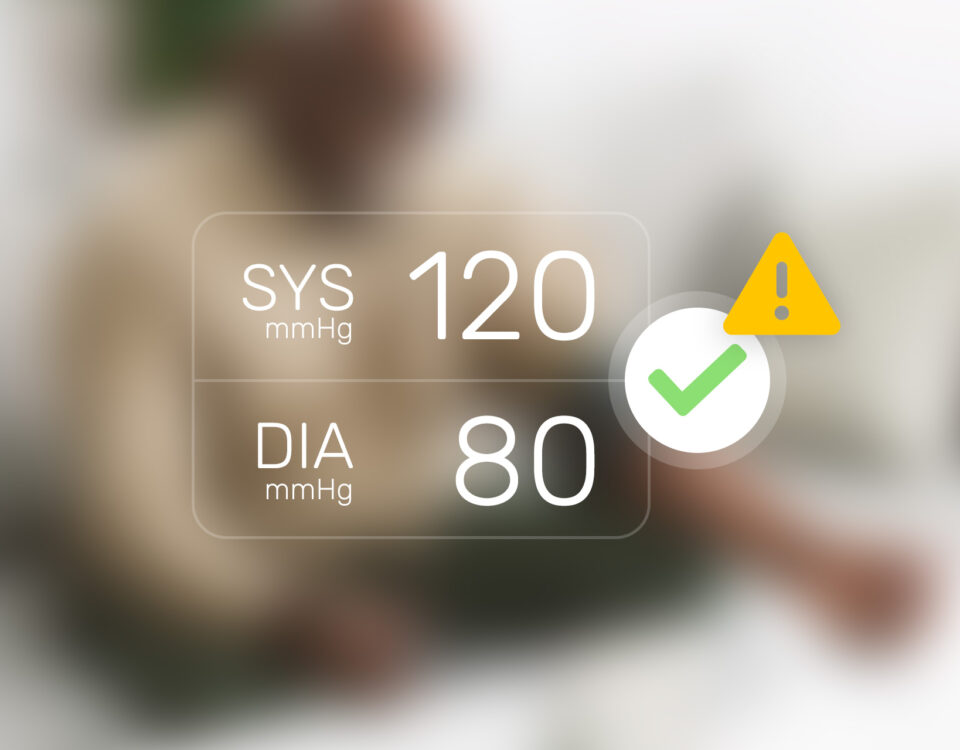Most fitness tracking focuses on effort—how fast your heart beats, how much oxygen your muscles consume, and how quickly you recover. But none of these metrics tell you whether your heart is efficiently supplying itself with oxygen when it needs it most.
That’s where SEVR (Subendocardial Viability Ratio) comes in.
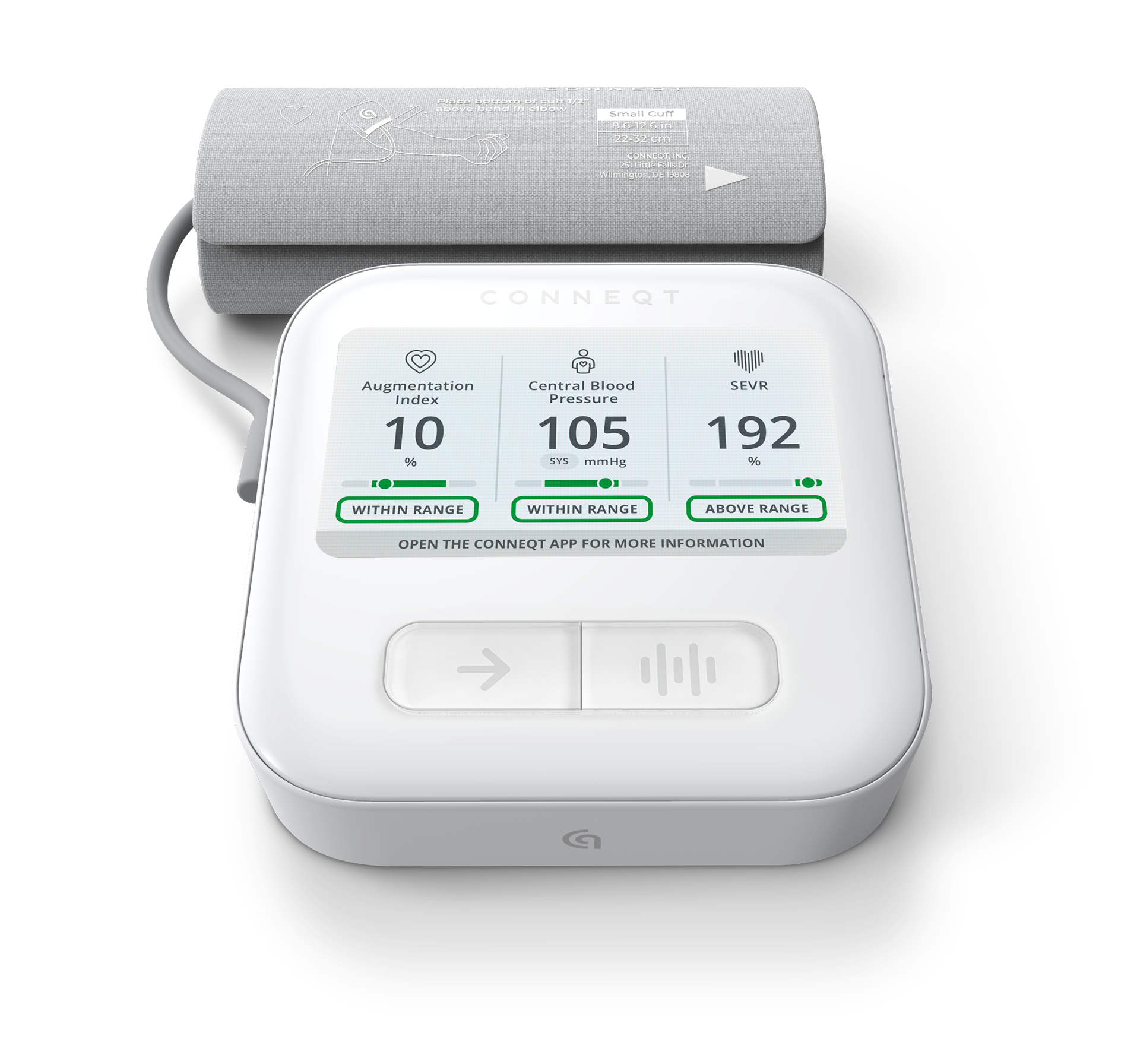
Measure what matters
Save 20% on checkout with code VITALITY
SEVR isn’t about how hard your heart is working—it’s about how well your heart is taking care of itself. Even if your heart rate, VO₂ max (the maximum amount of oxygen your body can use during exercise), and recovery scores look great, you could still be missing an important piece of the puzzle: how efficiently your heart is receiving the oxygen it needs to function properly.
What is SEVR and Why Does It Matter?
SEVR measures the balance between how much oxygen your heart is getting (during relaxation) and how much it needs (when it pumps). Specifically, it reflects oxygen supply to the subendocardium—the inner layer of the heart muscle, which is most vulnerable to oxygen deficits.
- When SEVR is high, your heart is efficiently delivering oxygen-rich blood to its tissues (a process called coronary perfusion), which is crucial for endurance and cardiovascular fitness.
- When SEVR is low, your heart may be struggling to get the oxygen it needs, meaning it’s working harder than it should.
Think of SEVR like fuel efficiency in a car. Your heart is the engine. Traditional fitness metrics tell you how fast you’re driving, but SEVR tells you whether your heart has enough fuel to sustain that speed without burning out.
Many assume that being fit guarantees good heart health, but even people who appear healthy can have low SEVR due to arterial stiffness or other hidden cardiovascular strain. That’s why tracking SEVR offers an entirely new way to assess cardiovascular efficiency and longevity.
How SEVR Reflects Your Heart’s Efficiency
Every time your heart beats, it needs oxygen to function. SEVR shows whether your heart is getting enough oxygen at the right time.
- During relaxation (diastole), your heart absorbs oxygen-rich blood—this is its supply.
- During contraction (systole), your heart pumps blood to the rest of your body—this is its demand.
- SEVR is the ratio between supply and demand, showing whether your heart is getting enough oxygen to sustain performance.
If your SEVR is high, your heart is efficiently managing its oxygen needs. If it’s low, your heart may be under strain, even if you feel fine. This makes SEVR a valuable early indicator of potential heart stress before symptoms appear.
What Traditional Fitness Metrics Miss About Heart Health
Most fitness tracking focuses on how much work your body can do—but they don’t reveal whether your heart is keeping pace with its own oxygen needs. SEVR fills this gap by providing a direct measurement of how efficiently your heart supplies itself with oxygen, something no other fitness metric offers.
The table below highlights the insights provided by SEVR alongside other key cardiovascular metrics:
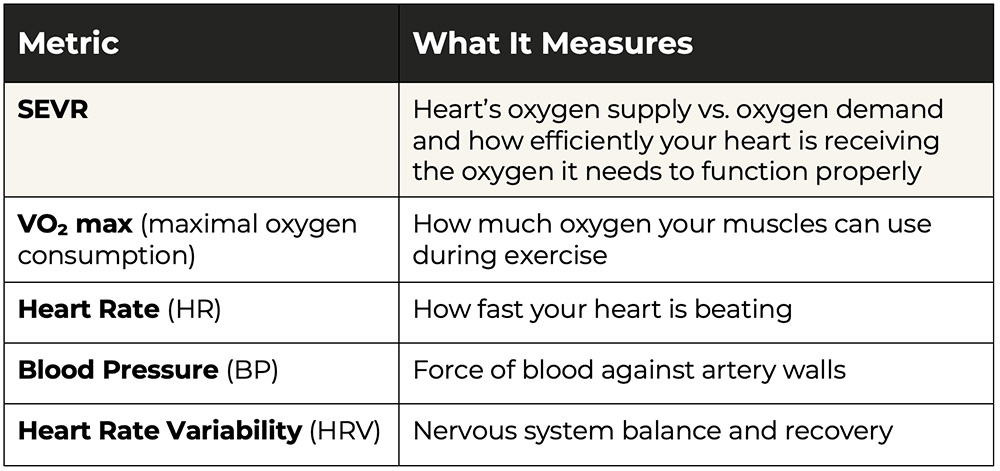
SEVR stands apart by offering a real-time measure of cardiovascular efficiency, revealing whether the heart is supplying itself with enough oxygen to function optimally. Unlike traditional fitness markers, SEVR provides insights into both heart performance and long-term arterial health, making it an essential tool for athletes, longevity-focused individuals, and those managing cardiovascular health. SEVR, Exercise Adaptation, and Arterial Health
One reason fit individuals tend to have higher SEVR values is that regular exercise trains the heart to work more efficiently. A 2023 study found that individuals with higher cardiorespiratory fitness (CRF)—a measure of how well the heart and lungs deliver oxygen during exercise—tend to have better SEVR values. This suggests that as VO₂ max improves, SEVR can serve as an additional metric to confirm that the heart’s oxygen supply is adapting alongside endurance, providing a more complete picture of cardiovascular fitness.
These two adaptations—a lower resting heart rate and more flexible arteries—help the heart maintain a better balance between oxygen supply and demand, resulting in a higher SEVR.
How Exercise Supports SEVR (Subendocardial Viability Ratio) and Prevents Arterial Stiffness:
- Aerobic Exercise (Running, Cycling, Swimming)
- Strengthens the heart muscle, allowing it to pump more blood with each beat, lowering resting heart rate.
- Enhances arterial flexibility, reducing resistance and improving blood flow.
- Trains the body to use oxygen more efficiently, reducing unnecessary strain on the heart.
- Resistance Training (Weightlifting, Bodyweight Exercises)
- Helps maintain arterial compliance, preventing blood vessels from stiffening.
- Reduces systolic pressure load, which supports a more balanced oxygen supply-demand ratio.
A 2017 study found that individuals with higher SEVR before starting a structured exercise program experienced greater improvements in heart function after training. This suggests that SEVR is not just a measure of fitness—it’s a predictor of how well the heart adapts and recovers from exercise.
SEVR, Aging, and Arterial Stiffness
As we age, arterial stiffness increases, making it harder for the heart to deliver oxygen efficiently. However, individuals with higher fitness levels tend to maintain better SEVR values, slowing the effects of vascular aging.
- This link between SEVR and longevity is well-documented. A study found that men under 60 with low SEVR had significantly higher mortality rates than those with normal or high SEVR. This underscores SEVR’s role as an early indicator of cardiovascular risk, reinforcing the importance of tracking SEVR over time to detect subtle signs of vascular decline—often before symptoms appear.
By maintaining consistent exercise habits, a heart-healthy diet, and effective stress management, individuals can help prevent arterial stiffness, preserve vascular flexibility, and optimize SEVR as they age, supporting both cardiovascular efficiency and longevity.
SEVR as a Predictor of Cardiovascular Risk
A low SEVR is not just a sign of inefficient oxygen use—it is associated with an increased risk of cardiovascular events.
- Research on hypertension suggests that individuals with an SEVR below 88% face a significantly higher risk of major cardiovascular events, making it a key predictor of long-term heart health.
- Many assume that being physically active guarantees a healthy heart, but SEVR provides a deeper look, showing that even well-conditioned individuals can have low values, indicating hidden cardiovascular strain.
- Studies in diabetic patients further reveal that women with type 2 diabetes tend to have lower SEVR values compared to men with diabetes and non-diabetic individuals, highlighting the importance of SEVR in identifying cardiovascular risk across different populations.
By monitoring SEVR over time, individuals can detect early warning signs of heart disease, even before they show up in traditional fitness assessments.
How to Measure SEVR
Tracking SEVR (Subendocardial Viability Ratio) requires specialized technology that assesses how efficiently the heart is supplying itself with oxygen. Unlike traditional heart rate monitors or blood pressure cuffs, SEVR measurement relies on pulse wave analysis (PWA)—a non-invasive method that evaluates the shape and timing of arterial pressure waves to determine key cardiovascular metrics, including arterial stiffness and coronary perfusion.
Pulse wave analysis works by measuring the pressure waveforms generated by each heartbeat. These waveforms contain valuable information about arterial health and the relationship between heart function and oxygen supply. SEVR is derived from the shape and timing of these waves, particularly the ratio between diastolic (relaxation) and systolic (contraction) phases.
The CONNEQT Pulse is a state-of-the-art device that makes SEVR tracking accessible and actionable. This clinically validated, non-invasive device provides a detailed arterial health assessment, including SEVR, by analyzing pulse waveforms in real time.
SEVR measurement bridges the gap between fitness tracking and arterial health assessment, offering insights that traditional heart rate or blood pressure readings miss. By incorporating pulse wave analysis and advanced vascular biomarkers, devices like the CONNEQT Pulse provide a more comprehensive picture of cardiovascular efficiency, helping individuals take a proactive approach to heart health.
Regularly monitoring SEVR can help detect early signs of cardiovascular strain, optimize fitness training, and support long-term heart function—making it a valuable addition to any health-conscious individual’s routine.
How to Improve SEVR (Subendocardial Viability Ratio)
Optimizing SEVR requires a comprehensive approach to strengthening the heart, improving circulation, and reducing strain.
Lifestyle Changes
Exercise (Improves Coronary Flow & Reduces Cardiac Workload)
Zone 2 Training (Low-Intensity Cardio):
- Activity: Walking, cycling, swimming
- Frequency: 4–5 days/week, 30–60 min
- Why? Enhances mitochondrial efficiency, reduces resting heart rate (HR), and improves coronary blood flow.
High-Intensity Interval Training (HIIT):
- Activity: Short bursts (30–60 sec) of intense effort (sprints, rowing, cycling)
- Frequency: 1–2 times per week
- Why? Improves heart rate variability (HRV), endothelial function, and nitric oxide (NO) production.
Resistance Training:
- Focus on Large Muscle Groups (Legs, Back, Chest)
- Why? Increases capillary density, improves blood pressure, and reduces cardiac afterload.
Sleep (Improves HRV & Reduces Stress)
- Sleep Duration: 7–9 hours
- Sleep Quality: Reduce blue light before bed, keep a cool bedroom, and avoid heavy meals late at night.
Stress Reduction (Lowers Heart Rate & BP)
- Breathing Techniques: Box breathing (4-4-4-4) or resonance breathing (6 breaths/min)
- Meditation: 10–15 min daily
- Cold Exposure: Cold showers or ice baths (activates vagus nerve)
- Nature Exposure: Walks in nature or grounding
Diet (Supports Vascular Function & Reduces Inflammation)
Artery-Healthy Foods (Boost Nitric Oxide & Reduce Oxidative Stress)
- Nitrate-Rich Foods: Beetroot, arugula, spinach, celery (boosts NO for vasodilation)
- Omega-3 Fatty Acids: Wild salmon, mackerel, sardines, walnuts, flaxseeds (anti-inflammatory)
- Polyphenols & Flavonoids: Dark chocolate (85%+ cacao), berries, green tea, olive oil (enhances endothelial function)
- Magnesium-Rich Foods: Pumpkin seeds, almonds, dark leafy greens (reduces arterial stiffness)
- Potassium-Rich Foods: Bananas, avocados, sweet potatoes, beans (lowers blood pressure)
- Garlic & Onions: Improves NO bioavailability, reduces arterial stiffness
Foods to Avoid (Reduce Inflammation & Oxidative Stress)
- Ultra-processed foods: Reduce trans fats, seed oils, and excess sugar.
- Excess Alcohol: Moderate intake (red wine in small amounts may help via polyphenols).
- High-Sodium Processed Foods: Excess salt can elevate BP if not balanced with potassium.
Supplements (Boost NO, Reduce Cardiac Load & Improve Mitochondrial Function)
Vasodilators (Improve Coronary Blood Flow & Endothelial Function)
- Beetroot Powder or Citrulline Malate (3–6g/day) → Boosts nitric oxide
- Arginine (3–6g/day) → Precursor to NO production
- Pycnogenol (100–200mg/day) → Increases endothelial NO synthesis
- Coenzyme Q10 (100–300mg/day) → Supports mitochondrial function & reduces BP
Blood Pressure & Arterial Health
- Magnesium Glycinate or Taurate (200–400mg/day) → Improves endothelial function & reduces BP
- Potassium (from food or supplements, 2–4g/day) → Regulates BP
- Hawthorn Extract (300–600mg/day) → Enhances coronary blood flow & reduces cardiac workload
Mitochondrial & Heart Function
- Taurine (1–3g/day) → Improves myocardial efficiency
- D-Ribose (5–10g/day) → Supports ATP production in cardiac tissue
- PQQ (10–20mg/day) → Enhances mitochondrial biogenesis
- NAD+ Precursors (NMN or NR, 250–500mg/day) → Supports cellular energy production
Monitor Key Metrics
- Resting Heart Rate (RHR): <60 bpm is ideal
- Heart Rate Variability (HRV): Higher is better (>50ms in most cases)
- Blood Pressure: Keep systolic <120 mmHg and diastolic <80 mmHg
- Coronary Calcium Score (CAC) & Endothelial Function Tests (if needed)
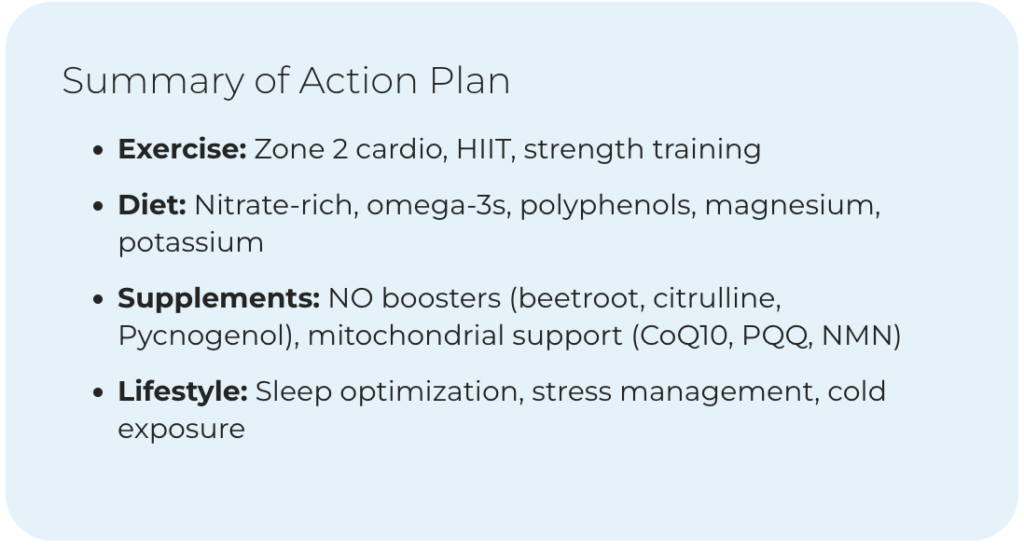
Optimizing Cardiovascular Efficiency: Why SEVR and Arterial Health Assessments Matter
Unlike step counts or heart rate, SEVR (Subendocardial Viability Ratio) requires a comprehensive arterial health assessment to provide deeper insights into cardiovascular efficiency. The CONNEQT Pulse offers a non-invasive way to measure SEVR and other key vascular biomarkers, giving you a clearer picture of how your heart and arteries function together. By tracking SEVR over time, you can monitor trends, optimize training and recovery, and take a proactive approach to improving long-term cardiovascular health.
With a complete arterial health assessment, CONNEQT provides insights that go beyond traditional heart rate and blood pressure measurements. By integrating SEVR tracking into your wellness routine, you can gain a better understanding of heart efficiency, longevity, and vascular resilience—helping you take charge of your cardiovascular health today for a healthier future.

